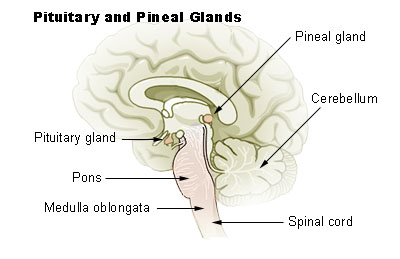Illu pituitary pineal glands.jpg
Diagram of pituitary and pineal glands in the human brain
Latin glandula pinealis
Gray's subject #276 1277
Artery posterior cerebral artery
Precursor Neural Ectoderm, Roof of Diencephalon
MeSH Pineal+gland
The pineal gland (also called the pineal body, epiphysis cerebri, epiphysis, conarium or the "third eye") is a small endocrine gland in the vertebrate brain. It produces the serotonin derivative melatonin, a hormone that affects the modulation of wake/sleep patterns and seasonal functions.[1][2] Its shape resembles a tiny pine cone (hence its name), and it is located near the centre of the brain, between the two hemispheres, tucked in a groove where the two rounded thalamic bodies join.
Nearly all vertebrate species possess a pineal gland. The most important exception is the hagfish, which is often thought of as the most primitive type of vertebrate.[3] Even in the hagfish, though, there may be a "pineal equivalent" structure in the dorsal diencephalon.[4] The lancelet amphioxus, the nearest existing relative to vertebrates, also lacks a recognizable pineal gland.[3] The lamprey, however (considered almost as primitive as the hagfish), does possess one.[3] A few "higher" types of vertebrates, including the alligator, lack pineal glands because they have been lost over the course of evolution.[5]
Contents
1 Location Get More Information About the Third Eye Click this link

No comments:
Post a Comment